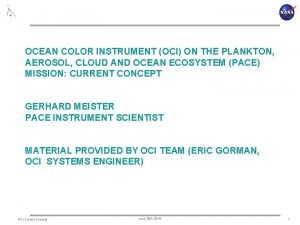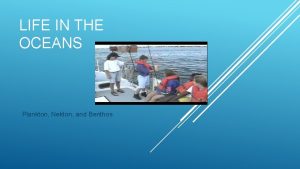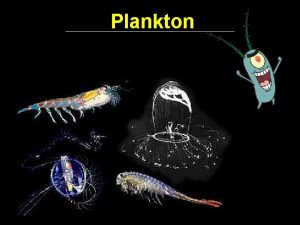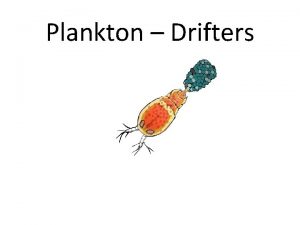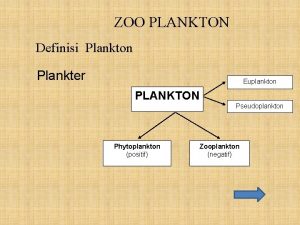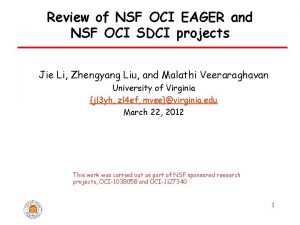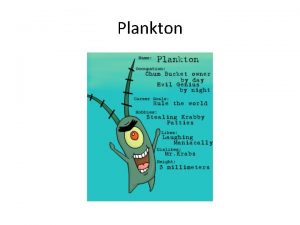OCEAN COLOR INSTRUMENT OCI ON THE PLANKTON AEROSOL
























- Slides: 24

OCEAN COLOR INSTRUMENT (OCI) ON THE PLANKTON, AEROSOL, CLOUD AND OCEAN ECOSYSTEM (PACE) MISSION: CURRENT CONCEPT GERHARD MEISTER PACE INSTRUMENT SCIENTIST MATERIAL PROVIDED BY OCI TEAM (ERIC GORMAN, OCI SYSTEMS ENGINEER) OCI Current Concept June 30 th, 2016 1

PACE/OCI threshold requirements (HQ) derived from SDT • 2 day global coverage • Hyperspectral (5 nm) from 350 nm to 800 nm, plus SWIR bands • Excellent long term trending (0. 1%) accuracy via lunar measurements • Low radiometric artifacts 0. 5% (striping, polarization, straylight, etc. ) • Spatial resolution of 1 km (at nadir) or better • Mitigation of sun glint • Equator crossing time: noon +/- 1 hour • Measurement of complete dynamic range of geophysical top-ofatmosphere radiances OCI Current Concept June 30 th, 2016 2

PACE & OCI Orbit Overview • Orbit Altitude – 675 km • Sun-Synchronous – Inclination ~98 degrees • Ascending Node – 1300 Equator Crossing Time • Orbit Period – ~98 Minutes • Orbits Per Day – ~14. 5 • Ground Velocity – ~6800 m/s or ~15, 000 MPH OCI Current Concept June 30 th, 2016 3

OCI Global Coverage • Cross Track Scanner like Sea. Wi. FS, MODIS, and VIIRS maximizes global coverage • Rotating telescope does a continuous 360 o rotation – Rotation Rate ~6 Hz or ~360 RPM • Field of Regard – – Scan angle +/- 56. 5 o ~2000 km per Scan Enables 1 -day global coverage 2 day global coverage considering sensor zenith angle limit of 60 o (corresponds to scan angle of ~48. 5 o in this case) OCI Current Concept June 30 th, 2016 4

OCI orbit operations – tilt and calibration 1. The S/C enters the day light over the south pole in an ascending node with the tilt mechanism is already set to the aft position (-20 o) 5 2. Collect science data starting when the S/C is at a 81. 5 o solar zenith angle 3. At the sub solar point move the tilt mechanism to the forward position (+20 o) – Stagger the time of tilt every 2 days, 2 days south, 2 days north 4 4. Continue to collect science data until the S/C is at a 81. 5 o solar zenith angle 5. Solar Calibration – The solar diffuser is mounted to view the aft sun. – Calibration occurs over the north pole before the S/C goes into the dark side 6. On dark side of the orbit reset the tilt mechanism to look aft (-20 o). Twice a month, perform lunar calibration with pitch maneuver on the dark side OCI Current Concept 3 6 1 June 30 th, 2016 2 5

Optical System Concept Approach • Sea. Wi. FS and Instrument Incubator Program (IIP) designs used as starting point • 2 hyperspectral channels, 6 separate SWIR channels • Dichroics and filters distribute bands onto respective detectors 600 mm 2250 nm SWIR channels Primary 2130 nm 1640 nm 1380 nm 450 mm Incoming light 1240 nm Depolarizer 940 nm Half Angle Mirror Slit Fold Flat Collimator Blue Hyperspectral channel: 340 nm-600 nm OCI Current Concept Red Hyperspectral channel: 600 nm-890 nm June 30 th, 2016 6

Grating disperses light on CCD for hyperspectral channels Telescope Dichroic Grating CCD (not shown) OCI Current Concept June 30 th, 2016 7

Main Optical Bench Tilts Fore and Aft for Glint Avoidance 20 o Aft Tilt View 20 o Fore Tilt View +Z NADIR +X RAAM +Y Cross Track Scan Direction of Telescope Rotation (West to East Scan) OCI Current Concept June 30 th, 2016 8

Data Acquisition as a function of scan angle Spacecraft o o . 5 46 . 5 51 +1 +1 • Similar to Sea. Wi. FS, MODIS, and VIIRS • Dark scan acquired every scan +X (Out of Page) +Y +Z Dark Scan (Once a scan) Scan Direction (West to East) No Data Solar Calibration No Data (Once a day for 30 s) No Da ta +56. 5 o ~-90 o ~-85 o Science Data +/- 56. 5 o -56. 5 o Earth OCI Current Concept June 30 th, 2016 9

OCI Telescope Ground Coverage • 1 Science Pixel = 1000 m x 1000 m at Nadir • OCI optics projects 16 science pixels onto a slit. The slit is reimaged onto detectors (CCDs and SWIR detectors) • This is 16, 000 m x 1000 m of ground area • If you stop the telescope from rotating, the optics will only see 16 science pixels on the ground. 1000 m 16 Science Pixels: 1000 m Each, 16, 000 m * Science Pixels are shown to approximate scale OCI Current Concept June 30 th, 2016 10

OCI Rotating Telescope Ground Coverage The rotating telescope moves the image of the 16 science pixels across the ground to cover the full field of regard The telescope rotates fast enough so there are no gaps in coverage in the along track direction between scans (scan progression determined by spacecraft speed, upward in this example) OCI Current Concept June 30 th, 2016 11

OCI Time Delay Integration The rotating telescope images the same science pixel area on the CCD 16 times. The detector uses TDI (time delay integration) to transfer the charge from pixel to pixel at the same rate 16 Science Pixels-1000 m Each, 16, 000 m Total of the rotating telescope This allows the telescope to view the same ground scene for an extended time and build up enough signal to meet SNR Calibration needed only for aggregate of detectors (good for lunar calibration, stripe suppression) Sea. Wi. FS used TDI with 4 photodiodes OCI Current Concept June 30 th, 2016 12

OCI -Time Delay Integration - Hyperspectral The optics are designed with a grating that splits the incoming light from each 16000 m x 1000 m ground scene into individual wavelengths, UV to NIR in 5 nm increments 890 nm 885 nm ………. . 880 nm 350 nm 345 nm 340 nm OCI Current Concept June 30 th, 2016 13

OCI CCD Detector 600 nm • Each science pixel is made up of 8 x 8 = 64 physical pixels. 595 nm 590 nm • The light collected at each ground scene and each 5 nm band is dispersed across 64 physical pixels 52 Spectral Bands: 416 Phys spectral spatial (125 m increments) OCI Current Concept 347. 5 nm 346. 9 nm 346. 2 nm 345. 6 nm 345 nm 344. 4 nm 343. 8 nm 343. 1 nm 350 nm 345 nm 340 nm 16 Science Pixels: 16*8*8 Physical Pixels June 30 th, 2016 14

OCI System Pixel Read Out & Pixel Aggregation ICDU Electronics Light from the earth is projected on the detector, TDI is done on the CCD OCI Current Concept Front End Electronics & DAU The front end electronics reads and digitizes the physical pixels and sends them to the ICDU (Instrument Command Data Unit) June 30 th, 2016 1000 m, λ=345 nm CCD Detector 1000 m, λ=345 nm The ICDU aggregates 8 x 8 physical pixels into a science pixel and sends it to the spacecraft 15

OCI CCD Detector Aggregation Options • Aggregating 8 x 8 pixels optimizes SNR for 1 km x 1 km, 5 nm pixel • Other aggregation options: 4 x 8 (4 in scan direction) produces a pixel that is only half as wide in scan direction, producing a 500 m x 1 km pixel (with lower SNR) • Other aggregation options: 8 x 1 (1 in spectral direction) produce pixels at different center wavelengths (but bandwidth is still 5 nm, determined by slit width). E. g. the 345 nm band could be sampled at 343. 125, 343. 75, 344. 375, 345. 0, 345. 625, 346. 875, and 347. 5 nm, again at lower SNR • Potentially useful for ocean Raman scattering, FLH, aerosol altitude; need to select spectral regions of interest, otherwise data volume issue 4 x 8 8 x 1 spectral spatial OCI Current Concept June 30 th, 2016 16

Potential for varying spatial aggregation: +X (Out of Page) +Y +Z Dark Scan (Once a scan) Scan Direction (West to East) No Data +45 o OCI Current Concept o o . 5 46 . 5 51 +1 +1 • Pixel size on the ground grows substantially for large scan angles • Possible option: instead of aggregating 8 x 8 pixels, aggregate 4 x 8 (similar to VIIRS aggregation) • Doesn’t apply to SWIR bands • Other options (e. g. 6 x 8) possible, but lead to mismatch with SWIR bands • Downside: lower SNR, o more calibration modes +56. 5 June 30 th, 2016 Solar Calibration (Once a day for 30 s) ~-90 o ~-85 o No Da ta Science Data +/- 56. 5 o -45 o 17

Options for CCD readout • Several spectral columns are read from the CCD in a “tap” • A “tap” is the read-out register for a number of columns of pixels • Project is studying various options for number of taps per CCD (influences e. g. readout speed, crosstalk, cost for electronics) • Shown below is which tap reads which 5 nm channel for a 10 tap example • This is important because gains on the CCD are set for each tab OCI Current Concept June 30 th, 2016 18

OCI SNR and Lmax at red wavelengths • PACE Project Science asked OCI team to increase SNR in red to 1400 (from 1000 PACE SDT) for FLH product • OCI team said this is only possible if we reduce the dynamic range for these bands by adjusting the CCD gain • The exact wavelength range is determined by CCD tap layout, which is not final at this moment (shown below: 10 tap example) • One option currently considered: Lmax reduced by 2/3 for ~650 nm 720 nm (see email to PACE Science Team from May 27, 2016) OCI Current Concept June 30 th, 2016 19

OCI SNR examples: high in the blue, little margin in red All values for multispectral bands OCI Current Concept June 30 th, 2016 20

Solar Diffuser calibration • Solar diffuser assembly has 3 panels which are rotated mechanically into position: -White, daily: Exposed, for daily monitoring of sudden changes in radiometric responsivity of the instrument - White, monthly: Protected, exposed once a month (28 Days) for long term trending - Doped, monthly: Protected, exposed once a month (28 days), to check spectral alignment of CCDs OCI Current Concept June 30 th, 2016 21

Lunar Calibration • Occurs twice a month (one month is 28 days) on the dark side of the orbit • Similar maneuver as Sea. Wi. FS, but spacecraft pitch rate is accurately controlled (no need to estimate oversampling factor) • ROLO model provides the model lunar irradiance (one value per band) • Lunar radiances are aggregated to calculate lunar irradiance => one value per band (irradiance) per maneuver OCI needs only one value per band for calibration (TDI) OCI Current Concept June 30 th, 2016 22

Current Trades Considered by the Project • • Extend UV range to 315 nm Spectral subsampling Spatial aggregation at scan edges Different tap layouts Dual gain for SWIR Reducing Lmax for additional wavelengths Bandwidths and Center Wavelengths for SWIR bands (e. g. 1640 nm) OCI Current Concept June 30 th, 2016 23

Conclusions • Many trades still on-going, final OCI will be different from what was presented here • OCI concept reduces number of gain coefficients per band to a minimum (one), eliminates striping, optimal for lunar calibration • Allows wide spectral coverage (UV-SWIR) • Provides 2 -day global coverage, glint avoidance like Sea. Wi. FS • Cross-track scanning is not optimal for SNR, but we expect to meet PACE SDT requirements; current concept indicates margin in blue channel; some SWIR bands may be “dual gain” • OCI concept anticipated to achieve requirements/objectives of PACE SDT option ‘OCI+’ and ‘Threshold Ocean Mission Requirements’ (Appendices I and II of PACE SDT) OCI Current Concept June 30 th, 2016 24
 Ocean color instrument
Ocean color instrument Divergent plate boundary
Divergent plate boundary Ocean ocean convergent boundary
Ocean ocean convergent boundary Convergent plate boundaries
Convergent plate boundaries Ocean ocean convergent boundary
Ocean ocean convergent boundary Nekton include all animals that
Nekton include all animals that Ocean to ocean convergent boundary
Ocean to ocean convergent boundary Ocean to ocean convergent boundary
Ocean to ocean convergent boundary Blue ocean strategi
Blue ocean strategi Active instrument is
Active instrument is Do salmon eat plankton
Do salmon eat plankton Photosynthetic phytoplankton
Photosynthetic phytoplankton Scientific name of oyster
Scientific name of oyster Plankton straining
Plankton straining What are plankton nekton and benthos
What are plankton nekton and benthos Plankton what
Plankton what Plankton straining
Plankton straining Greenfly carnivore
Greenfly carnivore Copopod
Copopod Holoplankton
Holoplankton Plankton
Plankton Plankton watch
Plankton watch Plankton.
Plankton. Plankton
Plankton Pick the odd one out
Pick the odd one out
